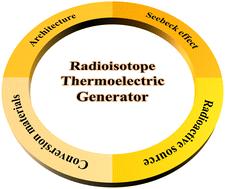当前位置:
X-MOL 学术
›
Chem. Commun.
›
论文详情
Our official English website, www.x-mol.net, welcomes your
feedback! (Note: you will need to create a separate account there.)
Radioisotope thermoelectric generators (RTGs): a review of current challenges and future applications
Chemical Communications ( IF 4.3 ) Pub Date : 2024-11-13 , DOI: 10.1039/d4cc03980g Muhammad Bilal Naseem, Junho Lee, Su-Il In
Chemical Communications ( IF 4.3 ) Pub Date : 2024-11-13 , DOI: 10.1039/d4cc03980g Muhammad Bilal Naseem, Junho Lee, Su-Il In

|
Nuclear power sources can be effectively employed to generate renewable energy as a counter to global reliance on fossil fuels and increasing energy demands. Nuclear radiation can be utilized in numerous ways to produce energy. Along with their use as fuel for nuclear power plants, the decay process of radioisotopes can also be used to create electrical energy. A radioisotope thermoelectric generator (RTG) is one such example, as it is tasked to convert the decay energy of radioisotopes into heat energy, which is later converted into electrical power using the Seebeck effect. Radioisotopes have high energy densities and certain isotopes can generate considerable heat energy for prolonged timescales. As such, RTGs have found applications in powering interplanetary exploration and interstellar space missions due to their long half-life. They are also commonly used in remote regions of the earth where frequent replacement, charging and maintenance of power sources is difficult. In this review, we will discuss the working principle and architecture of RTGs, challenges faced in further development and potential applications of this technology.
中文翻译:

放射性同位素热电发电机 (RTG):当前挑战和未来应用综述
核能可以有效地用于生产可再生能源,以应对全球对化石燃料的依赖和不断增长的能源需求。核辐射可以通过多种方式来产生能量。除了用作核电站的燃料外,放射性同位素的衰变过程还可用于产生电能。放射性同位素热电发电机 (RTG) 就是这样一个例子,因为它的任务是将放射性同位素的衰变能转化为热能,然后使用塞贝克效应将其转化为电能。放射性同位素具有很高的能量密度,某些同位素可以在较长时间尺度上产生相当大的热能。因此,由于 RTG 的半衰期很长,因此可用于为行星际探索和星际太空任务提供动力。它们也常用于地球上难以频繁更换、充电和维护电源的偏远地区。在这篇综述中,我们将讨论 RTG 的工作原理和架构、进一步发展面临的挑战以及该技术的潜在应用。
更新日期:2024-11-14
中文翻译:

放射性同位素热电发电机 (RTG):当前挑战和未来应用综述
核能可以有效地用于生产可再生能源,以应对全球对化石燃料的依赖和不断增长的能源需求。核辐射可以通过多种方式来产生能量。除了用作核电站的燃料外,放射性同位素的衰变过程还可用于产生电能。放射性同位素热电发电机 (RTG) 就是这样一个例子,因为它的任务是将放射性同位素的衰变能转化为热能,然后使用塞贝克效应将其转化为电能。放射性同位素具有很高的能量密度,某些同位素可以在较长时间尺度上产生相当大的热能。因此,由于 RTG 的半衰期很长,因此可用于为行星际探索和星际太空任务提供动力。它们也常用于地球上难以频繁更换、充电和维护电源的偏远地区。在这篇综述中,我们将讨论 RTG 的工作原理和架构、进一步发展面临的挑战以及该技术的潜在应用。


















































 京公网安备 11010802027423号
京公网安备 11010802027423号